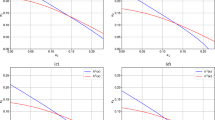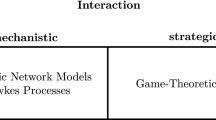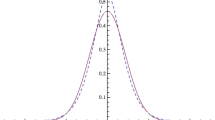Abstract
In this paper, supposing that the price process of the risky asset is described by a CEV stochastic volatility model, we investigate a stochastic differential investment and proportional reinsurance game problem with delay between two competing insurers. Each insurer’s risk process is described by the diffusion approximated process of the classical Cramér-Lundberg model. Each insurer can purchase the proportional reinsurance to mitigate their claim risks; and can invest in one risk-free asset and one risky asset whose price dynamics follows the CEV model. The main objective of each insurer is to maximize the utility of his terminal surplus relative to that of his competitor. For the representative cases of the mean-variance utility and exponential utility, we derive the explicit equilibrium reinsurance and investment strategies by applying the techniques of differential game theory and stochastic control theory. Finally, we perform some numerical examples to illustrate the influence of model parameters on the equilibrium reinsurance and investment strategies. Numerical simulation results indicate that: whether delay information and the elasticity parameter is considered or not will greatly affect the final equilibrium reinsurance strategy and optimal investment strategy. The more value of wealth at an earlier time is considered, the insurer will be more cautious and rational in their investment; however, the investment strategy of the insurer with the relative performance concern is riskier than that without the concern; meanwhile, the elasticity parameter will significantly affect the investment strategy of the insurer, and its influence trend varies with the price of risky assets.





Similar content being viewed by others
Data Availibility Statement
All data generated during the current study are available from the corresponding author on reasonable request.
References
Bai L, Guo J (2008) Optimal proportional reinsurance and investment with multiple risky assets and no-shorting constraint. Insurance Math Econom 42(3):968–975
Bai Y, Zhou Z, Xiao H, Gao R (2021) A Stackelberg reinsurance-investment game with asymmetric information and delay. Optimization 70(10):2131–2168
Bai Y, Zhou Z, Xiao H, Gao R, Zhong F (2022) A hybrid stochastic differential reinsurance and investment game with bounded memory. Eur J Oper Res 296(2):717–737
Bäuerle N, Leimcke G (2021) Robust optimal investment and reinsurance problems with learning. Scand Actuar J 2021(2):82–109
Bensoussan A, Siu CC, Yam SCP, Yang H (2014) A class of non-zero-sum stochastic differential investment and reinsurance games. Automatica 50(8):2025–2037
Björk T, Murgoci A (2010) A general theory of Markovian time inconsistent stochastic control problems. SSRN Electron J 1694759
Browne S (2000) Stochastic differential portfolio games. J Appl Probab 37(1):126–147
Chen L, Shen Y (2019) Stochastic Stackelberg differential reinsurance games under time-inconsistent mean–variance framework. Insurance Math Econom 88:120–137
Chen Z, Yang P (2020) Robust optimal reinsurance-investment strategy with price jumps and correlated claims. Insurance Math Econom 92:27–46
Chunxiang A, Lai Y, Shao Y (2018) Optimal excess-of-loss reinsurance and investment problem with delay and jump-diffusion risk process under the CEV model. J Comput Appl Math 342:317–336
Chunxiang A, Li Z (2015) Optimal investment and excess-of-loss reinsurance problem with delay for an insurer under Heston’s SV model. Insurance Math Econom 61:181–196
Deng C, Bian W, Wu B (2020) Optimal reinsurance and investment problem with default risk and bounded memory. Int J Control 93(12):2982–2994
Deng C, Zeng X, Zhu H (2018) Non-zero-sum stochastic differential reinsurance and investment games with default risk. Eur J Oper Res 264(3):1144–1158
Gu A, Guo X, Li Z, Zeng Y (2012) Optimal control of excess-of-loss reinsurance and investment for insurers under a CEV model. Insurance Math Econom 51(3):674–684
Gu A, Viens FG, Yao H (2018) Optimal robust reinsurance-investment strategies for insurers with mean reversion and mispricing. Insurance Math Econom 80:93–109
He Y, Xiang K, Chen P, Wu C (2021) Optimal investment strategy with constant absolute risk aversion utility under an extended CEV model. Optimization. https://doi.org/10.1080/02331934.2021.1954645
Huang Y, Yang X, Zhou J (2016) Optimal investment and proportional reinsurance for a jump-diffusion risk model with constrained control variables. J Comput Appl Math 296:443–461
Jin Z, Yin G, Wu F (2013) Optimal reinsurance strategies in regime-switching jump diffusion models: Stochastic differential game formulation and numerical methods. Insurance Math Econom 53(3):733–746
Li D, Rong X, Zhao H (2015) Time-consistent reinsurance-investment strategy for an insurer and a reinsurer with mean-variance criterion under the CEV model. J Comput Appl Math 283:142–162
Li D, Rong X, Zhao H (2016) The optimal investment problem for an insurer and a reinsurer under the constant elasticity of variance model. IMA J Manag Math 27(2):255–280
Lin X, Li Y (2011) Optimal reinsurance and investment for a jump diffusion risk process under the CEV model. North American Actuarial Journal 15(3):417–431
Lin X, Qian Y (2016) Time-consistent mean-variance reinsurance-investment strategy for insurers under CEV model. Scand Actuar J 2016(7):646–671
Liu B, Meng H, Zhou M (2021) Optimal investment and reinsurance policies for an insurer with ambiguity aversion. N Am J Econ Financ 55:101303
Liu J (2007) Portfolio selection in stochastic environments. Rev Financ Stud 20(1):1–39
Liu J, Yiu K-FC, Siu TK (2014) Optimal investment of an insurer with regime-switching and risk constraint. Scand Actuar J 2014(7):583–601
Meng H, Li S, Jin Z (2015) A reinsurance game between two insurance companies with nonlinear risk processes. Insurance Math Econom 62:91–97
Merton R (1969) Lifetime portfolio selection under uncertainty: The continuous-time case. Rev Econ Stat 247–257
Merton R (1971) Optimal consumption and portfolio rules in a continuous-time model. J Econ Theory 3(4):373–413
Shen Y, Meng Q, Shi P (2014) Maximum principle for mean-field jump-diffusion stochastic delay differential equations and its application to finance. Automatica 50(6):1565–1579
Shen Y, Zeng Y (2014) Optimal investment-reinsurance with delay for mean-variance insurers: A maximum principle approach. Insurance Math Econom 57:1–12
Shen Y, Zeng Y (2015) Optimal investment-reinsurance strategy for mean–variance insurers with square-root factor process. Insurance Math Econom 62:118–137
Shen Y, Zhang X, Siu TK (2014) Mean-variance portfolio selection under a constant elasticity of variance model. Oper Res Lett 42(5):337–342
Taksar M, Zeng X (2011) Optimal non-proportional reinsurance control and stochastic differential games. Insurance Math Econom 48(1):64–71
Wang N, Zhang N, Jin Z, Qian L (2021) Reinsurance-investment game between two mean-variance insurers under model uncertainty. J Comput Appl Math 382
Wang S, Rong X, Zhao H (2019) Optimal time-consistent reinsurance-investment strategy with delay for an insurer under a defaultable market. J Math Anal Appl 474(2):1267–1288
Wang Y, Rong X, Zhao H (2018) Optimal investment strategies for an insurer and a reinsurer with a jump diffusion risk process under the CEV model. J Comput Appl Math 328:414–431
Xu L, Zhang L, Yao D (2017) Optimal investment and reinsurance for an insurer under Markov-modulated financial market. Insurance Math Econom 74:7–19
Yang L, Zhang C, Zhu H (2022) Robust stochastic Stackelberg differential reinsurance and investment games for an insurer and a reinsurer with delay. Methodol Comput Appl Probab 24(1):361–384
Zeng X (2010) A stochastic differential reinsurance game. J Appl Probab 47(2):335–349
Zhang Q, Chen P (2018) Time-consistent mean-variance proportional reinsurance and investment problem in a defaultable market. Optimization 67(5):683–699
Zhang Q, Chen P (2020) Optimal reinsurance and investment strategy for an insurer in a model with delay and jumps. Methodol Comput Appl Probab 22(2):777–801
Zhao H, Weng C, Shen Y, Zeng Y (2017) Time-consistent investment-reinsurance strategies towards joint interests of the insurer and the reinsurer under CEV models. Science China-Mathematics 60(2):317–344
Zheng X, Zhou J, Sun Z (2016) Robust optimal portfolio and proportional reinsurance for an insurer under a CEV model. Insurance Math Econom 67:77–87
Zhou Z, Bai Y, Xiao H, Chen X (2021) A non-zero-sum reinsurance-investment game with delay and asymmetric information. Journal of Industrial & Management Optimization 17(2):909–936
Zhu H, Cao M, Zhang C (2019) Time-consistent investment and reinsurance strategies for mean-variance insurers with relative performance concerns under the Heston model. Financ Res Lett 30:280–291
Zhu H, Cao M, Zhu Y (2021) Non-zero-sum reinsurance and investment game between two mean-variance insurers under the CEV model. Optimization 70(12):2579–2606
Zhu J, Guan G, Li S (2020) Time-consistent non-zero-sum stochastic differential reinsurance and investment game under default and volatility risks. J Comput Appl Math 374
Funding
This work is supported by the National Natural Science Foundation of China (No.72171056), National Social Science Foundation of China (No.21FJYB025), Guangdong Basic and Applied Basic Research Foundation (No. 2023A1515012335).
Author information
Authors and Affiliations
Corresponding author
Ethics declarations
Conflicts of Interest
The authors declare that they have no competing interests.
Additional information
Publisher’s Note
Springer Nature remains neutral with regard to jurisdictional claims in published maps and institutional affiliations.
Appendices
Appendix A
Proof of Theorem 2. To solve (19)–(22), we try to conjecture the solutions in the following forms
with the boundary conditions \(A^i(T) = F^i(T) = 1\), \(B^i(T) = G^i(T) = 0\), and \(C^i(t,s) = H^i(t,s) = 0\). Substituting (48) with its partial derivatives into (19) and (21), we get
and
By differentiating (49) with respect to \(q_i\) and \(u_i\), we obtain
Substituting (51) back into (49) and (50), and conditionally on \(\varphi _i =\omega _i\mathrm {e}^{-\delta _ih_i}\), the following equations hold:
and
With the condition of \(\beta _1 + \omega _1 = \beta _2 + \omega _2\) in Theorem 2, and separating the variables with \(\left( \hat{x}_i + \omega _iy_i - \kappa _i\omega _jy_j\right)\), we obtain
Considering the boundary conditions, we have
To solve (58), we assume that \(H_i(t,s)\) admits the following affine form:
when substituting M(t) and N(t) into (58), we have
Matching coefficients yields
and
Recalling the boundary conditions, we can obtain
Similiarly, we can get that \(C_i(t, s)\) is a solution of the linear ordinary differential equations, which admits the form in (29).
Moreover, the time-consistent Nash equilibrium reinsurance-investment strategy of insurer i should satisfy
From (67), we can get explicit expressions for the equilibrium reinsurance and investment strategy of each insurer as displayed in (25) and (26).
The proof of Theorem 2 is completed.
Appendix B
Proof of Theorem 3.
To solve HJB Eq. (37), consider the following Ansatz:
with \(R_i(T) = 1\), \(O_i(T) = 0\) and \(\tilde{C}_i(T, s) = 0\), for all \(s \in \mathbb {R}\). By some simple calculation, we obtain the partial derivatives of \(W_i\), which are shown as follows
Inserting (68) and (69) into (37) yields
By differentiating (70) with respect to \(q_i\) and \(u_i\), we obtain
Substituting (71) back into (70), we obtain
With the condition of \(\beta _1 + \omega _1 = \beta _2 + \omega _2\) in Theorem 3, we can further get
By separating the variables with and without \(\left( \hat{x}_i + \omega _iy_i - \kappa _i\omega _jy_j\right)\), we can derive the following equations:
Considering the boundary conditions, we have
Substituting \(u_i^*(t)\) in (71) into the Eq. (76), we have
To solve (79), we assume that \(\tilde{C}_i(t,s)\) admits the following affine form:
when substituting \(\tilde{M}(t)\) and \(\tilde{N}(t)\) into (79), we have
Matching coefficients yields
and
Recalling the boundary conditions, we can obtain
Plugging \(R_i(t)\) and \(C_i(t,s)\) into (71) implies
From (85), the desired expressions of the Nash equilibrium strategies are given by (41) and (42).
This completes the proof of Theorem 3.
Rights and permissions
Springer Nature or its licensor (e.g. a society or other partner) holds exclusive rights to this article under a publishing agreement with the author(s) or other rightsholder(s); author self-archiving of the accepted manuscript version of this article is solely governed by the terms of such publishing agreement and applicable law.
About this article
Cite this article
Bin, N., Zhu, H. & Zhang, C. Stochastic Differential Games on Optimal Investment and Reinsurance Strategy with Delay Under the CEV Model. Methodol Comput Appl Probab 25, 54 (2023). https://doi.org/10.1007/s11009-023-10009-2
Received:
Revised:
Accepted:
Published:
DOI: https://doi.org/10.1007/s11009-023-10009-2




